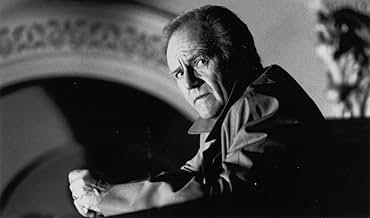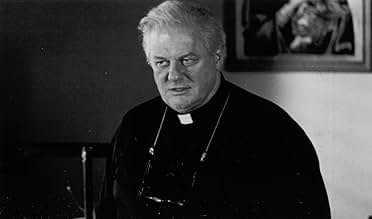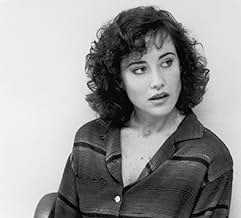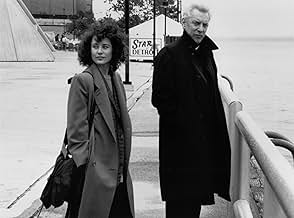IMDb-BEWERTUNG
5,8/10
1967
IHRE BEWERTUNG
Füge eine Handlung in deiner Sprache hinzuA priest is put in a dilemma when the serial killer who has been murdering priests and nuns confesses to him.A priest is put in a dilemma when the serial killer who has been murdering priests and nuns confesses to him.A priest is put in a dilemma when the serial killer who has been murdering priests and nuns confesses to him.
- Regie
- Drehbuch
- Hauptbesetzung
- Auszeichnungen
- 2 wins total
Empfohlene Bewertungen
Donald Sutherland plays Father Robert Koesler, a priest in Detroit who hears the confession of a murderer who is going around offing various priests and nuns. After doing some amateur sleuthing, Koesler figures out who the killer is. But he's bound by church law to say nothing. His superiors - among them, the hard nosed, conservative Ted Nabors (Charles Durning) - believe that nothing can violate the sanctity of the confessional. So, as you can guess, Koesler is a very troubled man. Koznicki (Josef Sommer), the detective on the case, is not as concerned with the rules of the Catholic church, aiming to catch himself a killer.
This sure sounds like a neat premise for a thriller, but on the whole the story isn't told in a particularly interesting way. The subplot of a potential romance, between Koesler and Pat Lennon (a reasonably appealing Belinda Bauer), really doesn't add anything to the material. Fred Walton ("When a Stranger Calls" '79, "April Fool's Day" '86) directs with competence and gives the proceedings a very somber quality. On location shooting ("The Rosary Murders" was actually filmed in Detroit) helps a bit, although the story doesn't exactly hold any surprises. (The killer turns out to be a truly disgusting piece of work.) That's too bad, considering that the two credited screenwriters are director Walton and the great author Elmore Leonard. There is a moment around the one hour mark that struck this viewer as simply too hard to swallow.
There are some solid actors and familiar faces among the cast: Anita Barone, Rex Everhart, Stefan Gierasch, Tom Mardirosian, Mark Margolis, James Murtaugh, Lupe Ontiveros, Addison Powell. But the movie is anchored the most by Sutherland, who plays Koesler as an easygoing, likable chap with a fairly progressive and compassionate attitude.
He and Durning manage to make this worth seeing.
Six out of 10.
This sure sounds like a neat premise for a thriller, but on the whole the story isn't told in a particularly interesting way. The subplot of a potential romance, between Koesler and Pat Lennon (a reasonably appealing Belinda Bauer), really doesn't add anything to the material. Fred Walton ("When a Stranger Calls" '79, "April Fool's Day" '86) directs with competence and gives the proceedings a very somber quality. On location shooting ("The Rosary Murders" was actually filmed in Detroit) helps a bit, although the story doesn't exactly hold any surprises. (The killer turns out to be a truly disgusting piece of work.) That's too bad, considering that the two credited screenwriters are director Walton and the great author Elmore Leonard. There is a moment around the one hour mark that struck this viewer as simply too hard to swallow.
There are some solid actors and familiar faces among the cast: Anita Barone, Rex Everhart, Stefan Gierasch, Tom Mardirosian, Mark Margolis, James Murtaugh, Lupe Ontiveros, Addison Powell. But the movie is anchored the most by Sutherland, who plays Koesler as an easygoing, likable chap with a fairly progressive and compassionate attitude.
He and Durning manage to make this worth seeing.
Six out of 10.
Murder mysteries generally speaking are criminal fantasies, outside of those based on real-life or so-called true crime. "The Rosary Murders" is based on a neo-noir novel by William X. Kienzle who was a real catholic priest. The story involves a series of murders associated with people in the catholic church, some laymen/laywomen while others are clergy. The murderer leaves behind a rosary. Donald Sutherland plays Father Koesler, a sort of priest-turned-detective. Also, at one point, the murderer confesses to the Koesler and he has to decide if he should break the church law of keeping confession confidential.
Typically, civilians outside of law enforcement are not supposed to engage in their own investigations of a crime being handled by the police. However in this story Father Koesler is given a lot of leeway to explore the case and interview witnesses. It turns out there's a backstory involving a nun who has entered into a cloistered convent where she has taken vows of silence. Koesler realizes she knows something crucial to the case.
Overall, I didn't find this film very entertaining. It was interesting, but also very gruesome and the overall feel was almost so real it was verging on not being terribly entertaining. Strangely films like "The Silence of the Lambs", though gruesome, are compelling from beginning to end. I didn't find that true with this film. Compelling but not really entertaining, and if it's not entertaining, what's the point?
Typically, civilians outside of law enforcement are not supposed to engage in their own investigations of a crime being handled by the police. However in this story Father Koesler is given a lot of leeway to explore the case and interview witnesses. It turns out there's a backstory involving a nun who has entered into a cloistered convent where she has taken vows of silence. Koesler realizes she knows something crucial to the case.
Overall, I didn't find this film very entertaining. It was interesting, but also very gruesome and the overall feel was almost so real it was verging on not being terribly entertaining. Strangely films like "The Silence of the Lambs", though gruesome, are compelling from beginning to end. I didn't find that true with this film. Compelling but not really entertaining, and if it's not entertaining, what's the point?
The author has relied heavily upon the literary device of COINCIDENCE in constructing his plot; i.e., he expects you to believe that several people living in the same part of the country would have certain proper names. I'd love to explain that in detail, but doing so would ruin part of the ending. Rent this movie and see if you agree. But this flaw will not diminish your enjoyment of the film, as there is enough action to keep the murder mystery fan happy. I was never bored during any of the times I watched this film. I recommend this any day of the week.
Donald Sutherland is a Detroit priest who hears the confession of a serial killer with a grudge against the clergy, and is later forced by the ethics of his vocation to (reluctantly) hunt down the murderer himself, unearthing a spine-chilling string of motivation behind each new death. It could have been just another routine shocker, but a clever script and some unusually taciturn direction turns the otherwise familiar material into a modest but intriguing whodunit (actually more a 'whydunit') set against the rituals and mysteries of the Catholic Church, always a reliable source of guilt and intrigue. The steady accumulation of clues and evidence is interrupted only by an unsurprising (and unnecessary) romantic subplot, which happily compromises neither the mystery itself nor Sutherland's oath of celibacy.
Is this a giallo? A neo-noir? A detective story? Let's not play with labels. Let's just see it for what it is — a whodunit where priests and nuns are the victims of a serial killer who leaves a black rosary on their dead bodies.
Directed by Fred Walton (When a Stranger Calls) and adapted by Elmore Leonard, this is a dark, rough take on William X. Kienzie's novel (Kienzie left the Catholc priesthood in 1974 after 20 years due to the Church's refusal to remarry divorced people). This may have been the only movie concerning the detective skills of Father Robert Koesler (Donald Sutherland), but the character appeared in twenty three more novels from Kienzie.
The character is a progressive priest — even falling for a reporter, Pat Lennon (Belinda Bauer, RoboCop 2, Flashdance). He serves with Father Ted Nabors (Charles Durning, Tootsie), who is the exact opposite — a racist throwback to pre-Vatican 2 who follows the Church to the letter of the law.
The central dilemma of the film? The killer confesses to Koesler, who can't do anything about it, thanks to the Church's Seal of Confession. But what if other lives — maybe even his own — are in danger?
The film was shot on location at Detroit's Holy Redeemer Parish, and if you look hard enough, you'll see an uncredited Jack White — years before The White Stripes — as an altar boy. That feels like it should be an urban legend, but it is true.
The film has what some describe as a leaden pace. There are some great moments in it, such as when Koesler hears the killer in a cemetery and the ending, where the real killer is revealed. I'm always debating with myself whether or not to spoil the ending. It's a thirty year old movie, but I feel weird doing so here. Must be the Catholic in me.
Read more at bandsaboutmovies.com/2017/08/16/the-rosary-murders-1987/
Directed by Fred Walton (When a Stranger Calls) and adapted by Elmore Leonard, this is a dark, rough take on William X. Kienzie's novel (Kienzie left the Catholc priesthood in 1974 after 20 years due to the Church's refusal to remarry divorced people). This may have been the only movie concerning the detective skills of Father Robert Koesler (Donald Sutherland), but the character appeared in twenty three more novels from Kienzie.
The character is a progressive priest — even falling for a reporter, Pat Lennon (Belinda Bauer, RoboCop 2, Flashdance). He serves with Father Ted Nabors (Charles Durning, Tootsie), who is the exact opposite — a racist throwback to pre-Vatican 2 who follows the Church to the letter of the law.
The central dilemma of the film? The killer confesses to Koesler, who can't do anything about it, thanks to the Church's Seal of Confession. But what if other lives — maybe even his own — are in danger?
The film was shot on location at Detroit's Holy Redeemer Parish, and if you look hard enough, you'll see an uncredited Jack White — years before The White Stripes — as an altar boy. That feels like it should be an urban legend, but it is true.
The film has what some describe as a leaden pace. There are some great moments in it, such as when Koesler hears the killer in a cemetery and the ending, where the real killer is revealed. I'm always debating with myself whether or not to spoil the ending. It's a thirty year old movie, but I feel weird doing so here. Must be the Catholic in me.
Read more at bandsaboutmovies.com/2017/08/16/the-rosary-murders-1987/
Wusstest du schon
- WissenswertesFilmed in part on location at Most Holy Redeemer Catholic Church in Southwest Detroit.
- PatzerA priest is called to the confessional from his quarters in the church. He walks across the altar to reach the confessional without genuflecting in front of the altar.
- Zitate
Father Edward Killeen: Break the seal of confession, and you destroy the Church.
Father Robert Koesler: People are going to die.
Father Edward Killeen: You're saving souls Bob, not lives.
- VerbindungenReferenced in Jersey Girl (2004)
- SoundtracksIN YOUR EYES
Recorded & Sung by Nancy Wood
Composed by Bobby Laurel
Lyrics by Bobby Laurel & Dennis Leahy
Based on an adaptation of the Third Symphony written by Johannes Brahms
Top-Auswahl
Melde dich zum Bewerten an und greife auf die Watchlist für personalisierte Empfehlungen zu.
- How long is The Rosary Murders?Powered by Alexa
Details
- Erscheinungsdatum
- Herkunftsland
- Sprache
- Auch bekannt als
- The Rosary Murders
- Drehorte
- Dearborn, Michigan, USA(scenic overview of the industrial area)
- Produktionsfirmen
- Weitere beteiligte Unternehmen bei IMDbPro anzeigen
Box Office
- Bruttoertrag in den USA und Kanada
- 1.730.337 $
- Weltweiter Bruttoertrag
- 1.730.337 $
- Laufzeit
- 1 Std. 45 Min.(105 min)
- Farbe
- Sound-Mix
- Seitenverhältnis
- 1.85 : 1
Zu dieser Seite beitragen
Bearbeitung vorschlagen oder fehlenden Inhalt hinzufügen




























